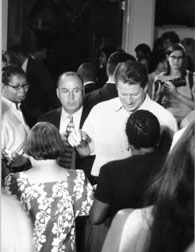Contents
By James B. Goodno
Not too long ago, cities figured prominently in national politics. As a result, presidential candidates offered urban programs as a matter of course, and public investment flowed into housing, community development, transportation, social welfare, and other city-centered programs. Not all of these programs were complete successes, but they pointed to the seriousness with which cities and urban constituencies were taken in the political process and by national political leaders.
In the 1980s and 1990s, major changes occurred as the nation’s political center shifted to the right and to the suburbs. Public investment came under attack as political demagogues — some motivated by ideology, others by corporate relations — exploited popular concerns about high tax bills to shift much of the political discourse against public investment. Rather than asking what we want from our government — and what we’re willing to do to get better schools, transit, housing, job training, health care, etc. — successful politicians of both parties began focusing attention on what we don’t want — high taxes, inflation, and, more recently, unbalanced budgets. The attraction of fiscal conservatism peaked around the same time the suburban soccer mom — described as holding conservative economic and moderately liberal social values — emerged as the icon of U.S. political competition.
Today, we’re beginning to see some changes in the political landscape. Republicans and Reformists remain committed to a vision of a minimalist state (but only when it comes to domestic economic and environmental matters) and voluntary or market-driven approaches to urban problems. But within the Democratic Party there are signs that fiscal conservatism — while still a most powerful force — might be losing some of its appeal. The reinvigoration of organized labor, the challenge from Ralph Nader and the Green Party, and the renewed attention given white working-class men (attention drawn by Joel Rogers and Ruy Teixiera’s America’s Forgotten Majority) has led Al Gore — the consummate moderate insider a.k.a. New Democrat — to campaign as a left-leaning populist.
Cities still receive short shrift in our political discourse. “We have become accustomed,” Bruce Katz, head of the Brookings Institution’s metropolitan program, accurately argues, “to talking about large national policies like welfare or health care or the environment, or tax and spending priorities, without any mention of cities or places.”
But Gore’s campaign — and Nader’s insurgency — at least provides the opportunity to reintroduce an urban voice into national politics. In its modern form, that voice might be part of a metropolitan chorus, bringing together the concerns of working-class suburbanites, harried commuters, and residents of featureless subdivisions and declining urban neighborhoods, singing praises of smart growth, high-road economic development, and investment in our urban future.
The Significance of Public Investment
By most measures, our economy has rarely done better than it is performing now. For nine years, economic output has been growing steadily. For close to five years, it’s been growing at a surprisingly rapid pace. Unemployment is bottoming out, and homeownership is higher than ever. Inflation has yet to rear its ugly head.
This boom won’t last forever, but for now prosperity represents opportunity and opportunity lost. Opportunity is found in the growing affluence of the typical American. Real wages are finally rising, allowing many of us to live a bit better than we did 15 or 20 years ago.
Yet in our prosperous nation, we still have cities and regions that lag behind. These are places like Syracuse, New York, where neighborhoods are dotted with abandoned homes, and Benton Harbor, Michigan, where more than half the population lives in poverty. In our wealthier cities and metropolitan regions, we have thousands who can not afford adequate housing. Low-wage service workers are among the housing poor, but so are middle-income professionals and blue-collar workers who have been priced out of housing markets by skyrocketing rents and housing costs.
Opportunity has been lost because of the nation’s failure to invest a sufficiently large portion of the fruits of prosperity in housing and transportation. It’s been lost because the demand for adult education and retraining exceeds supply. It’s been lost because political power shifted to more affluent suburbs where these market failures — while not invisible — have been less evident (until recently) and easier to ignore, and because public investment has not been sufficient to overcome the problems created by market failures. The connection between social problems and insufficient public investment is starkly evident in the housing sector.
“When I worked for HUD under President Carter, the government underwrote upwards of 300,000 units a year, and now we’re about a quarter of that assistance,” observes Steve Cole, head of the AFL-CIO housing and investment trust. “Five years ago, in the beginning of this boom, $5 billion were cut from housing assistance. So it’s no surprise that every major successful city that I visit when we go to invest — and we invest about $1 billion a year in cities and development projects — the streets are filled with homeless people and business leaders are complaining they can’t find workers because people can’t find housing.”
Similarly, public transportation programs suffer from a shortage of funds. The federal government is committing record amounts to transit, but this is failing to keep up with demand. Congestion, the transfer of jobs to suburbs, and growing distances between where people live and work has cities, counties, and other local entities competing for transit funding, and the federal government coming up short.
The nation’s mayors and county executives — Republicans, Democrats, and third-party members alike — have made public investment a centerpiece of their presidential agenda this year. Members of the U.S. Conference of Mayors and the National Association of Counties call for fresh infusions of federal funds into housing, infrastructure, and education. They also want to see the creation of a White House domestic policy czar, who would coordinate and lead federal efforts to address urban and metropolitan problems.
Certainly, other issues are important to cities and urban constituencies. “The five-year limitation on welfare benefits should also be made more flexible,” notes Jeff Faux, president of the Economic Policy Institute, in the American Prospect. Affirmative action, immigration rights, crime prevention, and fair policing, to name a few, appeal to our sense of racial justice. Open space protection and environmental regulation respond to our desire for clean and healthy communities. Targeted tax cuts and abatements, higher minimum wages, and public-private partnerships in brownfield redevelopment win support as pieces of an economic development and justice agenda. But a commitment to public investment has to be front and center on a national urban agenda.
A Shrub Grows in Texas
Steve Bartlett is a former Dallas mayor and member of Congress. A staunch Republican and head of a financial industry trade group, Bartlett is a vocal supporter of George W. Bush. At a Brookings Institution conference earlier this year, Bartlett encapsulated Republican thinking on the relationship between Capitol Hill and City Hall.
“I think the big urban story for the 1990s has been that the solution doesn’t lie in Washington but the discovery that the solution lies with effective leadership at the local level, that has acted perhaps with some federal resources, but certainly not with federal policies, and sometimes in spite of federal policies,” Bartlett said.
It’s not hard to pick apart Bartlett’s comment — how can federal resources be delivered without federal policies? — but even taken at face value it has dubious worth. A close reading of Bush’s campaign material and position papers reveals little evidence that Bush would invest anything near the resources required in the future of our cities. His urban policies are a patchwork quilt of mom-and-apple pie homilies, symbolic overtures, and market-based solutions to problems that often are the result of market failures.
Bush dedicates more attention to brownfield redevelopment than to any other urban issue. This is not surprising. Bush is a product of the oil industry, and the oil industry owns massive shuttered industrial sites — generally old refineries — that are awaiting redevelopment. It would benefit from the streamlined regulatory process, limits on post-remediation liability, and lower environmental standards Bush proposes. Many brownfields experts and even community activists agree that liberalized policies could hasten brownfields redevelopment and economic revitalization of impacted communities, but putting the authority to reduce environmental standards into Bush’s hands is like inviting Freddy Krueger into your dreams: It’s nightmare time. Texas leads the nation in air pollution and ranks poorly in other environmental categories. (Ditto Hang ’em High Bush’s tough-on-urban-crime posture.)
To serve “the needy,” Bush favors public support — mostly through tax law changes but also through grants and the creation of a special presidential office — for faith-based initiatives. This move, which has won applause from the Christian right and some African-American preachers, recognizes the legitimate achievements of social action by churches and synagogues, but raises controversial political and perhaps constitutional questions regarding separation of church and state. Moreover, this politically calculated move — and all candidates make politically calculated moves — allows Bush to appear compassionate without committing the government to meeting the needs of the down and out.
That Bush’s is a thoroughly conservative bid is perhaps best evinced by the failure of Patrick Buchanan’s Reform Party campaign to gain any traction outside the most militant social and economic conservatives. Despite the Bush name and all his talk about compassion, the Texas governor captured the support of most hard-right institutions and personalities relatively early on. This alliance between corporate conservatives and hard-right activists does not augur well for urban advocates or residents.
Nader or Gore?
If Buchanan’s challenge to Bush on the right fizzled amidst Reform Party contretemps — reality came to resemble a Doonesbury cartoon — Ralph Nader’s engagement with Gore from the left has had more staying power. Early on, Nader showed enough strength to threaten Gore’s chance of victory, especially in key Midwest states, where voter anguish — especially working-class anguish — about the steady march of free trade raised doubts about and anger against the vice president amongst important unionized industrial workers. Gore had already opened himself to a challenge from the left by aligning himself early on with the conservative New Democrat wing of the party on welfare reform, crime, the death penalty, and military spending and aggressively courting corporate and wealthy donors. (To be fair, even before the campaign shifted to the left, Gore had his progressive concerns: He’s long been a defender of trade union rights, he continues to back affirmative action, and he’s strong on social security.)
Most telling, while Gore has supported — even led — the administration’s efforts to strengthen transportation funding, encourage livable communities, and attend to the problems of distressed cities and regions, the vice president has steadfastly adhered to a conservative fiscal stance that emphasizes balanced budgets and debt reduction over public investment. Even in a recession, when deficit spending makes particular economic and social sense, Gore says he would cut back on government expenditures, “just as a corporation has to cut expenses when revenues fall off, and that sometimes turns out for the long-term benefit of a company,” the vice president says. “Calvin Coolidge couldn’t have said it better,” Jeff Faux counters.
Nader’s challenge to Gore has not focused on urban issues. The Green Party platform contains some activist-pleasing planks on affordable housing (emphasizing partnerships among nonprofits, the private sector, and government), public transportation, parks, diversity, community involvement, the living wage, and other urban concerns. But the Nader campaign has not focused attention on these issues. Corporate power and trade issues stirred his passions. On transportation he’s focused more attention on better automobiles than public transportation, and he’s absented himself from the national dialogue on race. So silent has Nader been, contends Vanessa Daniel of the Applied Research Center, that “many activists of color have been repelled by Nader.”
From a metropolitan perspective, Gore has become the most interesting candidate to watch. He’s the only candidate to have a clearly articulated urban agenda, and he’s supplemented that agenda with a commitment to assisting communities and regions develop smart-growth practices.
“Al Gore believes we can and must expand our economic prosperity to all our urban communities,” his campaign declares. “To fulfill the vast potential of America’s cities, Al Gore wants to reform and revolutionize our public schools, ensure our cities are safe from crime and violence, invest in a world class transportation system, and spur private investment and job creation.”
Behind the rhetoric are promises to expand programs that help underserved communities attract private investment through tax benefits and seed money, clean up brownfields, provide tax credits for programs targeting the urban environment, investing in public education (while opposing voucher schemes), providing low-income housing tax credits, encouraging mixed-income and innovative public housing development, and expanding investment in public transit.
Gore also supports regional planning initiatives, building around transit hubs, and other land-use practices identified with the smart-growth movement and recognizes the importance of adult education and retraining in a changing economy. These characteristics and stances make Gore an attractive candidate, but his willingness to take the steps needed to truly invest in our urban future is questionable. Gore has been criticized for thinking big but acting small. “One of his proposals was $17 million to buy back land,” says the AFL-CIO’s Coyle of Gore’s smart-growth initiative. “Seventeen million dollars for a nation.”
A Seat at the Table
Would Gore invest sufficiently in our cities and metropolitan regions? Probably not. Would Bush be a disaster for our cities? In some ways yes, in some ways probably not. What of Nader and Buchanan?
Whoever is elected president, cities and metropolitan regions will have to continue to fight to have their voices heard and to receive the support they need to address their problems. In these times of prosperity, the challenges are steep enough. In the event of an economic downturn — which could well happen on the next president’s watch — they could become frightening.
There are, however, reasons to be guardedly optimistic. The convergence of Nader’s third party bid and the reinvigoration of labor and the recognition of the importance of working-class voters to the Democratic Party have created the conditions for the possible emergence of a metropolitics alliance — inner city and working-class suburban — on a national scale. The reemergence of an urban populist coalition suggests the dominance of the New Democrats — despite their control over the party platform — is not all it’s made out to be. A renewed commitment to sufficient public investment might not be in the offing, but it can be put on the table, especially as concern about housing, transportation, and the end of the economic boom mounts.
Turning out urban and working-class suburban voters might not deliver all that cities need, but it’s the best way for urban America to reclaim a seat at the table.







